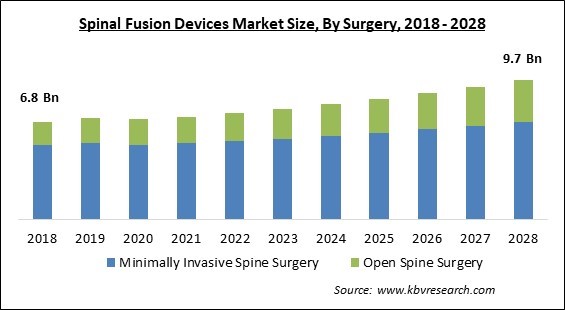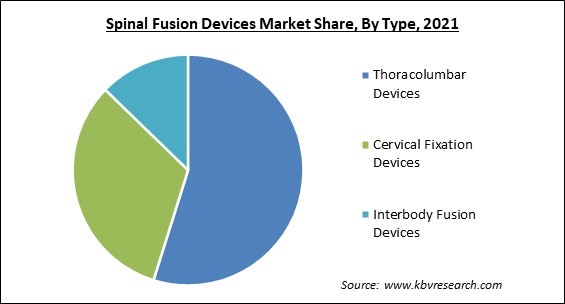The Global Spinal Fusion Devices Market size is expected to reach $9.7 billion by 2028, rising at a Market growth of 4.6% CAGR during the forecast period.
Spinal instrumentation also called spinal implants, devices, or hardware involves the implantation of titanium, stainless steel, titanium-alloy, or non-metallic items into the spine by surgical procedures. Spinal instrumentation is a long-term remedy for spinal instability. Medical implants come in a variety of forms, styles, and sizes, all of which are designed to treat spinal diseases in people of all age groups. Spinal fusion devices are used to treat spondylolisthesis and degenerative disc disease, as well as other spinal abnormalities. The rise in the elderly population along with the rise in the prevalence of spinal disorders is driving the Market 's growth. Furthermore, the Market is expected to rise as the number of indications for spinal fusion surgery grows. For example, spinal fusion was once reserved for spinal tuberculosis & scoliosis, but it is now used to treat 14 other disorders.
In men & women over the age of 50, spine problems like spinal stenosis are the most common condition. The elderly, especially those with comorbidities and/or reduced immunity, are at a higher risk of spinal abnormalities. With the emergence of new-age spine fusion and gadgets, spine-level therapy choices are always increasing. In addition, the usage of these implants and devices is one of the most successful and well-recommended treatments for spine misalignments and degenerative alterations. The trend toward less invasive spine operations, the rise in the prevalence of spinal illnesses, and innovations in spine surgery are all major factors driving the growth of the spinal fusion devices Market .
Surgeons are choosing MIS over open surgery for a variety of reasons, including less pain, a shorter recovery time, and less tissue damage. Minimally invasive procedures are being used to treat a wide spectrum of bone problems. In the United States, around 400,000 spinal fusion procedures are performed each year, making it one of the most prevalent and well-established treatment choices for spine trauma, degenerative conditions, and structural anomalies.

COVID-19 has spread all over the world. In addition, because of a rise in the number of coronavirus patients, governments all over the world have implemented several regulations and lockdowns, resulting in the closure of manufacturing & production operations of companies in the spinal fusion devices industry. Moreover, as surgeons and Practitioners focus on treating corona patients, hospitals have announced reductions, postponement, or cancellations of elective procedures, including many orthopaedic and spine cases. This break in the flow of business operations and other relevant activities has a direct impact on the Market . As a result, the above-mentioned factors are estimated to restrain the growth of the spinal fusion devices Market .
Surgical robots are increasingly being used in the spine treatment industry, with several hospitals now giving robotic surgery for the treatment of numerous spinal injuries and disorders. Many companies are focusing on developing surgical robots that may be utilized in conjunction with their implants & navigation aids in spinal fusion surgery. This has majorly increased the number of strategic partnerships as well as new product launches, all of which are estimated to propel the Market forward. Medtronic announced the launch of Mazor X Stealth Edition, a robotic system for spine surgery, in January 2019. The technology may be combined with the company's navigation, spine implants, and 3D imaging capabilities to provide healthcare providers with a complete solution.
The Market for spinal arthrodesis devices is fiercely competitive, with major competitors launching new and sophisticated products regularly to sustain their position in the Market . Moreover, minimally invasive operations are gaining adoption around the world, prompting manufacturers to introduce devices designed specifically for minimally invasive spinal fusion surgery. Alphatec Spine, for instance, announced the commercial introduction of Invictus, a spine fixation platform created for open, minimally invasive, or hybrid surgical procedures, in July 2019. The increasing number of advancements and innovations in the spinal fusion devices would significantly boost demand for these devices.
A fusion entails substantial bone grafting, which might result in increased back discomfort and an increased healing time. Throughout a fusion, the lateral facet joints & transverse processes, which are parts of pine that are placed on the sides of each vertebra, are usually exposed. More muscle dissection is required as a result. Bone grafts or bone substitutes are also used in the spine to aid in the gradual fusion of the bones, although this might cause inflammation, which can add to additional scarring, or arachnoiditis, and pain.

Based on Surgery, the Market is segmented into Minimally Invasive Spine Surgery and Open Spine Surgery. The Open Spine surgery garnered substantial revenue share in spinal fusion devices Market in 2021. The growing desire for open spine procedures among medical professionals, the increasing incidence of spinal abnormalities, and technological breakthroughs in spinal fusion surgery all contribute to growth of this segment. Tele audiology can be a useful approach for persons who are experiencing hearing loss during this period to get the care that eliminates or limits conventional face-to-face engagement.
Based on Type, the Market is segmented into Thoracolumbar Devices, Cervical Fixation Devices, and Interbody Fusion Devices. The Cervical Fixation devices segment procured a significant revenue share in the spinal fusion devices Market in 2021 because of rapid adoption of spine navigation software and attractive health insurance coverage. Cervical plates help fusion by keeping the construct stable. The novel cervical interbody device is comprised of titanium alloy and is cylindrical. The device collects bone material needed for fusion as it is inserted between two vertebrae.
Based on End User, the Market is segmented into Hospitals, Specialty Clinics, and Others. The Hospitals segment acquired the highest revenue share in spinal fusion devices Market in 2021. Because of the increasing adoption of advanced spine surgery products along with the progressive growth in the number of robotic spine surgeries, in addition hospitals are witnessing significant cost savings from spinal fusion procedures, which is expected to boost the Market even further.
| Report Attribute | Details |
|---|---|
| Market size value in 2021 | USD 7.2 Billion |
| Market size forecast in 2028 | USD 9.7 Billion |
| Base Year | 2021 |
| Historical Period | 2018 to 2020 |
| Forecast Period | 2022 to 2028 |
| Revenue Growth Rate | CAGR of 4.6% from 2022 to 2028 |
| Number of Pages | 199 |
| Number of Tables | 340 |
| Report coverage | Market Trends, Revenue Estimation and Forecast, Segmentation Analysis, Regional and Country Breakdown, Companies Strategic Developments, Company Profiling |
| Segments covered | Surgery, Type, End User, Region |
| Country scope | US, Canada, Mexico, Germany, UK, France, Russia, Spain, Italy, China, Japan, India, South Korea, Singapore, Malaysia, Brazil, Argentina, UAE, Saudi Arabia, South Africa, Nigeria |
| Growth Drivers |
|
| Restraints |
|
Based on Regions, the Market is segmented into North America, Europe, Asia Pacific, and Latin America, Middle East & Africa. North America acquired the highest revenue share of the spinal fusion Market in 2021. The regional Market is likely to be fueled by a significant increase in the number of spinal fusion procedures performed in ambulatory surgical centers and outpatient settings, as well as the rapid use of spine navigation tools and surgical robots. Significant number of adults in the United States experienced chronic pain in 2016, with few among them experiencing high-impact chronic pain. During the projection period, this is likely to boost demand for spine fusion implants in the United States.
Free Valuable Insights: Global Spinal Fusion Devices Market size to reach USD 9.7 Billion by 2028
The Market research report covers the analysis of key stake holders of the Market . Key companies profiled in the report include Zimmer Biomet Holdings, Inc., Johnson & Johnson, Stryker Corporation, B. Braun Melsungen AG, Medtronic PLC, Alphatec Holdings Inc., Globus Medical, Inc., NuVasive, Inc., Orthofix Medical, Inc., and Exactech, Inc.
By Surgery
By Type
By End User
By Geography
The global spinal fusion devices market size is expected to reach $9.7 billion by 2028.
Rising number of novel innovations across the spinal fusion Market are increasing are driving the market in coming years, however, risk of spinal discomfort & longer healing time due to bone grafting growth of the market.
Zimmer Biomet Holdings, Inc., Johnson & Johnson, Stryker Corporation, B. Braun Melsungen AG, Medtronic PLC, Alphatec Holdings Inc., Globus Medical, Inc., NuVasive, Inc., Orthofix Medical, Inc., and Exactech, Inc.
The Minimally Invasive Spine Surgery segment is leading the Global Spinal Fusion Devices Market by Surgery 2021, thereby, achieving a Market value of $6.8 billion by 2028.
The Thoracolumbar Devices segment acquired maximum revenue share in the Global Spinal Fusion Devices Market by Type 2021, thereby, achieving a Market value of $5.2 billion by 2028.
The North America Market dominated the Global Spinal Fusion Devices Market by Region 2021, and would continue to be a dominant Market till 2028; thereby, achieving a Market value of $3.2 billion by 2028.
Our team of dedicated experts can provide you with attractive expansion opportunities for your business.

